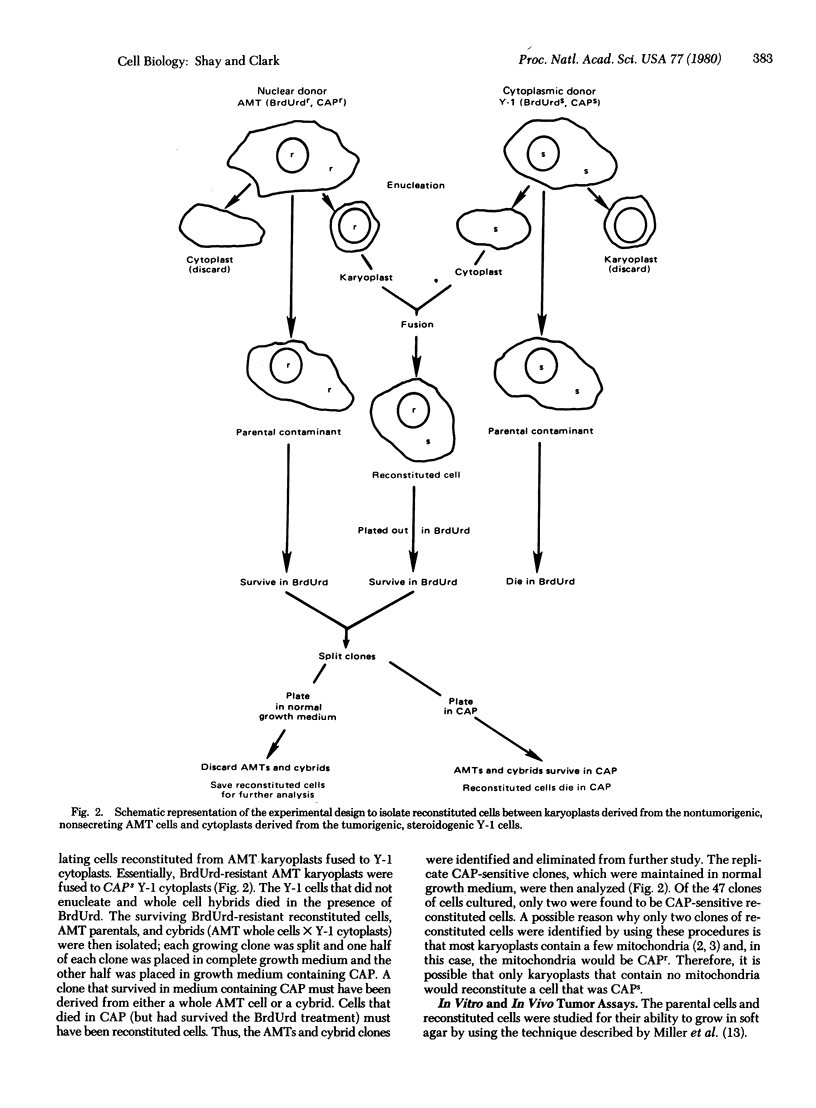Abstract
Enucleation techniques combining mild centrifugation in the presence of cytochalasin B permit cells to be separated into nuclear fragments (karyoplasts) and cytoplasmic fragments (cytoplasts). These fragments, though stable for a short time, will ultimately degenerate by the procedures described in this report. One can, however, fuse cytoplasts to karyoplasts by using polyethylene glycol and obtain viable reconstituted cells whose properties may be useful for understanding some aspects of the nuclear-cytoplasmic interactions associated with tumorigenicity and steroidogenesis. However, the presence of cybrids, hybrids, and parental whole cell contaminants along with the reconstituted cell population make it necessary to have genetic markers that reside in both the nucleus and cytoplasm in order to preferentially identify reconstituted cells derived from a karyoplast fused to a cytoplast. By utilizing the Y-1 cell line, which is tumorigenic and responds to corticotropin by secreting steroids, and the AMT-BU-A1 (AMT) cell line, which is nontumorigenic and does not respond to corticotropin but has a nuclear marker, BrdUrdr, and a cytoplasmic marker, CAPr, we have reconstituted cells containing Y-1 karyoplasts and AMT cytoplasts. In this report we extend our previous techniques by describing an identification procedure that allowed us to isolate cells reconstituted from AMT karyoplasts fused to Y-1 cytoplasts. The results of these experiments support the concept that with these cell lines the nucleus (karyoplast) is ultimately sufficient to control the phenotypic expression or suppression of tumorigenicity and steroidogenesis.
Keywords: enucleation, polyethylene glycol-induced fusion, steroidogenesis, tumorigenicity
Full text
PDF



Selected References
These references are in PubMed. This may not be the complete list of references from this article.
- Bunn C. L., Wallace D. C., Eisenstadt J. M. Cytoplasmic inheritance of chloramphenicol resistance in mouse tissue culture cells. Proc Natl Acad Sci U S A. 1974 May;71(5):1681–1685. doi: 10.1073/pnas.71.5.1681. [DOI] [PMC free article] [PubMed] [Google Scholar]
- COHEN A. I., FURTH J., BUFFETT R. F. Histologic and physiologic characteristics of hormone-secreting transplantable adrenal tumors in mice and rats. Am J Pathol. 1957 Jul-Aug;33(4):631–651. [PMC free article] [PubMed] [Google Scholar]
- Clark M. A., Shay J. W. The response of whole and enucleated adrenal cortical tumor cells (Y-1 cells) to ACTH treatment. Scan Electron Microsc. 1979;(3):527–535. [PubMed] [Google Scholar]
- Hayflick L. Tissue cultures and mycoplasmas. Tex Rep Biol Med. 1965 Jun;23(Suppl):285+–285+. [PubMed] [Google Scholar]
- Miller C. L., Fuseler J. W., Brinkley B. R. Cytoplasmic microtubules in transformed mouse x nontransformed human cell hybrids: correlation with in vitro growth. Cell. 1977 Sep;12(1):319–331. doi: 10.1016/0092-8674(77)90210-0. [DOI] [PubMed] [Google Scholar]
- Schneider E. L., Stanbridge E. J., Epstein C. J. Incorporation of 3H-uridine and 3H-uracil into RNA: a simple technique for the detection of mycoplasma contamination of cultured cells. Exp Cell Res. 1974 Mar 15;84(1):311–318. doi: 10.1016/0014-4827(74)90411-x. [DOI] [PubMed] [Google Scholar]
- Shay J. W., Peters T. T., Fuseler J. W. Cytoplasmic transfer of microtubule organizing centers in mouse tissue culture cells. Cell. 1978 Aug;14(4):835–842. doi: 10.1016/0092-8674(78)90339-2. [DOI] [PubMed] [Google Scholar]
- Shay J. W. Selection of reconstituted cells from karyoplasts fused to chloramphenicol-resistant cytoplasts. Proc Natl Acad Sci U S A. 1977 Jun;74(6):2461–2464. doi: 10.1073/pnas.74.6.2461. [DOI] [PMC free article] [PubMed] [Google Scholar]
- Temple R., Wolff J. Stimulation of steroid secretion by antimicrotubular agents. J Biol Chem. 1973 Apr 25;248(8):2691–2698. [PubMed] [Google Scholar]
- Veomett G., Prescott D. M., Shay J., Porter K. R. Reconstruction of mammalian cells from nuclear and cytoplasmic components separated by treatment with cytochalasin B. Proc Natl Acad Sci U S A. 1974 May;71(5):1999–2002. doi: 10.1073/pnas.71.5.1999. [DOI] [PMC free article] [PubMed] [Google Scholar]


